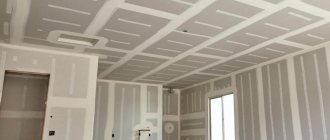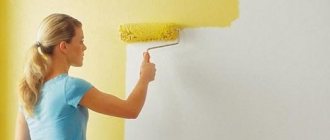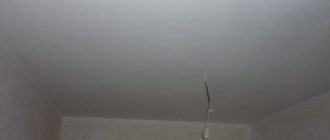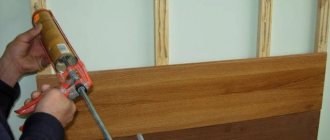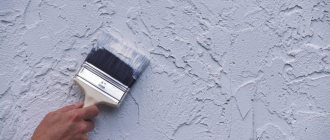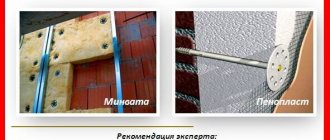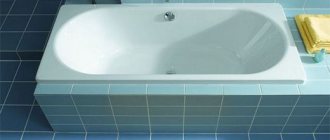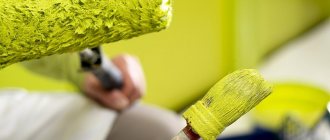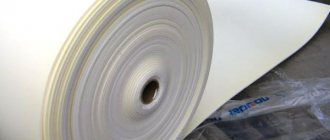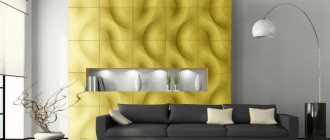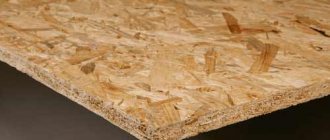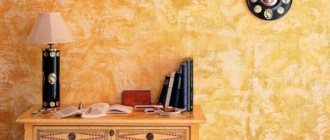OSB boards are a good alternative to expensive building materials. Widely used in the installation of floors, ceilings, and internal partition structures. The aesthetic appearance of the material allows it to be left without any finishing. However, quite often OSB is subjected to finishing - painting or applying decorative plaster, with preliminary putty. Whether it is possible to putty an OSB board, how to putty an OSB under wallpaper or painting, as well as the application rules will be discussed in this article.
Why and in what cases is OSB puttying used for interior and exterior work?
The material consists of slabs and sheets made from pressed chips (up to 150 mm long). They have several layers (3 or more). Thin chips are laid in different directions, which increases the resistance of the material to mechanical damage and deformation. Chipboards are pressed. The bonding of wood chips is ensured by resinous substances.
The abbreviation OSB stands for oriented strand board. But the American version is often used - Oriented Strand Board, or OSB. This material has a number of advantages. For example, due to its composition (the slab is 90% wood), it is noted for its environmental friendliness.
Due to the fact that the material exhibits the same properties as wood, there are disadvantages. The main one is low resistance to moisture. Accordingly, putty is used to protect OSB panels from negative external factors, as well as to improve the appearance of the coating.
The main reasons for using particle boards:
- prevention of exposure to moisture contained in the material used for decorative surface finishing;
- protection from UV radiation, humid air;
- reducing the risk of deterioration in the external qualities of the coating due to resinous substances that gradually appear on the surface;
- protection against formaldehyde contained in OSB boards;
- elimination of irregularities to improve the external qualities of the coating when performing certain decorative finishing methods;
- masking wood panels to create the illusion of using other types of material (for example, concrete).
Most often, OSB structures require decorative finishing. This is due to the unattractive appearance of the sheets. When using most finishing materials, it is necessary to create a smooth rough surface of the base, for example, if painting is carried out using the standard method or OSB putty under wallpaper.
They also note decoration methods that do not require leveling. These include varnishing, textured painting, installation of laminate or panels of various types. In the first case, the goal is not to disguise the natural structure of the material, but to create an emphasis on it. The varnish allows you to get a thin transparent layer, thanks to which the structure is visible, but at the same time provides reliable protection from moisture.
Textured coloring makes it possible to hide defects and the structure of the rough base material. This creates a decorative coating with unusual external properties.
The use of panels allows you to do without putty, because in this case the particle boards are completely covered. But, if you plan to perform external work, additional protection from moisture is required.
Features of OSB boards
Oriented strand board is produced by pressing large chips of softwood wood. The gluing process occurs when exposed to high temperature under pressure. Synthetic resin serves as the adhesive material. In addition, the composition contains boric acid and synthetic wax. The products are quite durable and are not subject to delamination, which guarantees a long service life.
Before you putty the OSB board, you need to familiarize yourself with the characteristics and advantages of using the material, including:
- strength of structures - due to the direction of the chips in one direction;
- moisture resistance - special treatment protects the material from rotting and swelling under the influence of water or moisture;
- fire resistance – coating with special substances ensures complete resistance to fire;
- resistance – characteristic of negative natural influences, including fungus, insects, etc.;
- lightness – the slabs are light in weight and are available in various sizes.
Good to know! When purchasing, do not forget to pay attention to moisture resistance indicators, which may vary between different brands of products.
Choosing putty for OSB: what is better to putty indoors and on the facade
The simplest and most accessible to use are gypsum and cement mixtures. They allow you to get a durable coating. But in most cases, such OSB putty is not taken into account when choosing a composition for finishing the rough base. The reason is low resistance to deformation due to natural processes (changes in the volume of particle boards). The rough base expands under the influence of moisture and temperature changes.
As a result, the layer of cement or gypsum putty will quickly move away from the surface. This will lead to a decrease in the protective properties of the coating and a reduction in the service life of OSB boards. Under the layer of decorative finishing, the particle boards will absorb moisture. At the same time, the risk of mold development will increase and the strength of the structure will decrease.
For this reason, it is important to carefully choose what to putty on the OSB board. The most suitable are elastic mixtures. They resist deformation of the rough base material, do not lag behind the surface, and therefore last much longer. The best types of putty include: adhesive, oil, synthetic, etc.
Materials for OSB protection are divided into groups, taking into account differences in structure:
- ready-made putty - viscous composition;
- dry mixture.
The first option is preferable, since it does not require mixing the components yourself. In this case, there is a risk of reducing the quality of the mixture. Ready-made putty does not have this drawback, but it is distinguished by its high cost.
The second option is affordable, but if you lack experience, there is a risk of ruining the putty. The use of low-quality material will reduce the level of protection of OSB boards.
Oil-adhesive putty
Main components:
- glue;
- oil (drying oil);
- substances that accelerate the drying of film-forming compositions;
- filler (chalk);
- plasticizer - a component that increases the elasticity of the coating;
- water.
This type of mixture is often used as putty on OSB boards in rooms, provided that they are well heated. The material helps eliminate defects smaller than 0.5 cm.
Some types of oil-adhesive putty create a coating layer no more than 1-2 mm thick. The mixture is recommended to be used for leveling OSB before painting or before wallpapering.
Advantages of this type of putty:
- high drying speed: between layers up to 3 hours, complete hardening with increased coating strength - up to 24;
- the coating is characterized by elasticity and can withstand moderate loads that contribute to deformation;
- the absence of harmful components, which is important when finishing OSB panels containing formaldehyde even in small doses;
- the mixture is spread evenly on wooden, concrete, and plastered structures.
Oil-adhesive putty for OSB also has disadvantages. This is not a high enough reliability of the finished coating. Low resistance to moisture and gradual loss of properties during storage are also noted.
Polymer putty
One of the best ways to protect a structure made from OSB boards is to use an elastic mixture based on latex or acrylic. Chalk and talc are used as fillers. The composition includes film-forming components. The scope of application of polymer-based putty is wide. It is used for leveling if there are minor defects, in order to eliminate significant curvature of the surface. Cement compositions with the addition of polymer components are also noted.
When asked whether it is possible to putty an OSB board with this mixture, the answer will be positive.
Moreover, different types are used:
- universal - suitable for finishing structures made of wood, concrete and other materials;
- special - designed for working with wood.
Advantages of polymer putty:
- the finished coating does not deform as it dries and does not shrink;
- elasticity;
- vapor permeability;
- high adhesion to any material;
- strength;
- long service period.
The material has no significant shortcomings. The increased cost needs to be highlighted. But this drawback is justified by the properties of the putty when working with OSB sheets.
Other
In addition to the options considered, there is putty:
- epoxy;
- alkyd.
Both varieties provide resistance to mechanical stress. At the same time, increased adhesion of the finished coating and the finishing layer of finishing material is noted. But epoxy putty, like alkyd putty, is less often used for application to areas of structures made of OSB sheets of a significant area (walls, ceilings). This is due to the high price.
Tips for choosing materials
Before puttying, the surface is first sanded and then primed. To carry out the work, material is selected based on a number of requirements, namely:
- Choice of primer. It is necessary to prime with special mixtures intended for wood processing. As a rule, these are compositions based on drying oil or glyphthalic varnish that do not contain water. The end parts of the OSB are first treated with primer mixtures even before the sheets are installed, since this is very problematic to do afterwards. The primer will help prevent stains from resins and other substances contained in the material.
- Choice of putty. You should opt for compounds intended for finishing wooden bases. The walls should be plastered in several layers, horizontally and vertically, which will provide a more even surface. It is also worth remembering that in order to avoid cracks after drying, it is recommended to reinforce the surface with elastic materials, for example, non-woven fabric.
Advice! It is preferable to buy already polished slabs, the price of which is not much higher, but the finishing work will be much faster.
What tools will you need?
Regardless of whether putty will be used for OSB boards for painting, before gluing wallpaper or finishing in another way, prepare:
- sandpaper of different grain sizes;
- serpyanka;
- rubber spatula;
- wide spatula;
- roller, brush;
- roulette;
- container for mixing components (if dry mass is purchased);
- construction mixer.
Types of putty compounds
OSB boards consist of more than 80% natural solid wood, so it would be correct to use mixtures intended for wooden surfaces. Putty for OSB boards is presented in a fairly wide range on the modern market.
Puttying osb boards can be carried out using the following leveling agents:
- Oil-adhesive compositions are products based on oil varnishes in addition to drying oil and other fillers.
- Adhesive compositions - putties based on oils, adhesive solutions and plasticizers can be made at home.
- Nitro putties are quick-drying compounds that contain cellulose ethers, resins, plasticizer fillers and a certain amount of solvents.
- Gypsum mixtures are putty for OSB boards containing gypsum and polymer additives.
- Compositions with latex are an order of magnitude more expensive than the previous ones, and represent the most suitable option, based on their fairly long service life.
It is highly not recommended to putty osb using dry mixtures for concrete or brick coatings. This finish will last on the stove for no more than a month.
If you don’t know how to putty an OSB board, choose mixtures for wood processing, which should be indicated on the product packaging.
On video: how to choose putty.
Puttying OSB on walls
There are different finishing options. You can putty on OSB boards for painting or wallpaper. For this purpose, the sheets are prepared: they are sanded to remove the surface layer and removed from dust.
Instructions to make puttying easier:
- A primer is used. The surface is treated twice. Particular attention is paid to the end sections. After the initial application, take a break. You must wait until the layer of material dries. Start the priming procedure again. To do this, use a roller or brush.
- The joints of OSB boards are puttied.
- Grind the treated areas after the composition has dried.
- Fiberglass mesh is installed along the entire wall.
- Fix the metal slats in the corner areas (external).
- Add 2 tbsp to the finished acrylic putty. l. PVA glue (increases adhesion and strength).
- Cover the wall with the prepared mixture. The procedure is repeated three times (with breaks of up to 12 hours).
- Perform grinding.
- To strengthen the mixture, you need to prime the last layer with a special compound intended for finishing application.
Preparatory work for puttying
In order for the finishing of OSB boards to last longer, the surface should be primed before starting cladding. This is necessary because the wood structure of osb panels does not adhere well to finishing compounds. Putty without primer will “come off”, requiring frequent repairs.
Preparation consists of two stages:
- After installation of the sheets, the paraffin protective layer is removed from them.
- Remove dust from the panel using a grinding machine or machine and a damp cloth.
Puttying OSB on ceilings
The instructions for walls are taken as a basis, but they take into account how to putty OSB on the ceiling. A number of features are noted:
- prime the surface only with a brush, then remove excess material with a spatula - remove the drops;
- the fiberglass mesh is not fixed with a stapler, it is secured with putty (when applying the first layer);
- The mixture should be scooped onto a spatula in small quantities.
When applying each next layer, the direction of movement of the tool changes: first parallel to the window, then from it to the opposite wall.
The process of puttying the prepared surface
If you want to save on purchasing ready-made mixtures, you can make your own putty composition from the following ingredients:
- turpentine - 60 g;
- perlite - 30 g;
- gelatin - 20 g;
- casein - 20 g;
- linseed oil - 280 g;
- borax - 12 g;
- water - 300 ml;
- 18% ammonia solution - 170 g.
Sequencing:
- Mix the perlite crushed to powder with linseed oil until smooth.
- Add turpentine and stir.
- Let sit for 10 minutes and add the remaining ingredients.
- Keep in a water bath, stir and remove to infuse. After this, the mixture can be used.
Features of puttying OSB boards before certain types of wall and ceiling cladding
Recommendations for finishing the rough foundation before starting work with different types of materials:
- painting - careful leveling is performed, step-by-step sanding is required (with a special tool or coarse, fine-grained sandpaper);
- panels of different types - OSB putty is not required, you just need to fill the joints of the sheets with elastic material and apply a primer;
- wallpapering - there is no need to carefully level the finishing layer, minor defects are acceptable;
- tiles - a special type of primer is applied to OSB boards: epoxy, film-forming (if you plan to finish rooms with a high level of humidity);
- liquid wallpaper, plaster - concrete contact is applied over the putty to increase adhesion.
Recommendations from the experts
Experts who know the secrets of working with OSB boards recommend treating the ends of each panel with a primer before covering the walls.
Before applying the putty layer, all joining areas are glued with serpyanka. Surface reinforcement is a mandatory process.
If you plan to paint the walls, their surface is puttied. But if wallpaper is used, this finishing option is performed if necessary.
OSB panels themselves are considered a fairly smooth material, and in the case of gluing vinyl or non-woven wallpaper with a thick base, it is not necessary to putty the slabs. It is enough to sand the surface and treat it with a primer mixture. The putty material is applied when the final finishing is planned using thin wallpaper.
To make the sanding process easier, it is recommended to buy slabs that have undergone this treatment during the production process. This way you will save time and effort.
Decorative putty on OSB
The goal when working with decorative putty mixtures is to prepare the surface (OSB sheets).
It is done this way:
- remove the protective layer;
- a primer is applied that provides increased adhesion (concrete contact) in 2 layers;
- prepare putty, but in small quantities, because it hardens quickly (after 30 minutes), an elastic mixture (acrylic, silicone) is best suited for this purpose.
To give the desired relief, different types of spatulas and rollers are used.
Nuances of choice and application features
The wrong choice of putty composition and poor-quality OSB finishing can lead to redoing the entire repair. To minimize errors at this stage, it is better to choose ready-made putty without the need for mixing. Also, a good material should have the following properties:
- High adhesion for strong adhesion to resinous OSB sheets.
- Homogeneous consistency without small impurities.
- Low shrinkage to avoid cracks.
- Dense structure when dry.
- Suitability of the coating for subsequent finishing.
- Elasticity to compensate for expansion of the slab under the influence of temperature and humidity.
Puttying for any further finishing occurs in the same way:
- padding. The OSB wood surface must be carefully treated to prevent resinous secretions that interfere with adhesion. After application, the primer must dry for 5-10 hours;
- puttying. It is necessary to apply an even thin layer in a room with a humidity of no more than 60% and a temperature above +5 degrees;
- grinding. For a high-quality finish, the surface must be smooth and even.
The puttying steps are simple; you can handle them yourself without any special skills. However, failure to observe technological breaks and the wrong choice of material for the room can have a bad effect on the final finish. In such cases, it is better to turn to professionals, and you can entrust the choice of putty to the managers of osbmarket.ru. For a free consultation, call the hotline number.
Popular brands
To putty an OSB board for painting, wallpaper or other finishing material, consider mixtures of different brands.
The products of the following brands are especially in demand:
- SOPPKA - universal mixture (for OSB and other types of particle boards);
- NEOMID - polymer composition, produced on a water basis;
- Semin sem - used indoors and outdoors, is universal (can be applied to different types of structures).
Before purchasing, you need to consider the material consumption. In addition, they evaluate how the puttyed OSB sheets will behave: will they be deformed or will they be protected from moisture.
Preparation is the Key to Success
Many people ask, is it possible to putty OSB board? Yes, but only after careful surface preparation. The process consists of a set of works. The first step is to improve the adhesion between the materials and close all the pores of the wood. This is why you need a surface primer. The optimal mixture option is Ceresit TsT17. After all, OSB has a textured and porous structure. And the applied primer Ceresit has deep penetration.
The next step after the primer has dried is to seal the cracks and technological gaps. You need putty for OSB. It hides all gaps and joints up to 10 mm in size. The ideal putty option for gaps is Knauf Rotband paste.
Next, a fiberglass reinforcing mesh is mounted on the surface. Thanks to it, the putty layer will not crack, will stay well on the surface and will not be damaged at the corners. The canvas is well stretched and fixed using a construction stapler. An overlap of 10 cm is made at the joints. The end of the mesh should not be at an angle. There should be no sagging.
The staples are driven in in increments of 100–150 mm.
The last stage of preparation of particle boards is the installation of mounting angles. They protect corners from damage, extending the service life of the finish. The corner is also fixed with a stapler into the perforated areas.
Alternative ways to protect OSB seams and gaps
There are fans who believe that the strand board itself looks beautiful and is not worth covering. However, the finishing coating performs another important function besides the decorative one - it protects the sheets from the destructive effects of the external environment. When panels are left open, harmful effects on them must be minimized.
Firstly, you cannot remove the factory paraffin layer - it at least slightly protects the wood from moisture and the resin from the destructive effects of ultraviolet radiation.
Secondly, it is better to use a variety of oil impregnations to increase the service life of the casing.
Thirdly, the most vulnerable places on OSB sheets are the joints. From the ends, these wooden products remain uncovered and, from there, the process of decay and rotting most often begins. Therefore, it is advisable to close the gaps, even if the panels remain bare.
To make the sealed cracks look beautiful, they are decorated and highlighted as much as possible. For these purposes, they are covered with wooden slats, filled with sealant and painted over. You can also fill prepared joints with plastic or translucent polycarbonate profiles.
This contrasting combination looks very attractive, and when the entire surface is covered with stain, the slabs can serve without deteriorating for a very long time.
Preparatory stage
The main distinctive quality inherent in oriented strand board, used to create a partition or level the internal walls of a house, is its relatively low weight and high moisture resistance. In addition, such plates:
- Affordable.
- Easy to use.
- Easily processed.
- Hardy and resistant to various kinds of negative influences.
Priming is carried out in several stages.
Before you putty the surface of a wall or partition built from oriented strand boards, it must be treated with a primer mixture. Choose a deep penetration primer that dries quickly and does not reduce the level of adhesion inherent in the compounds used in subsequent processing.
The first layer of the composition is applied by generously wetting the surface of the slabs. Re-processing begins no earlier than 10-12 hours after complete drying. The second layer of the primer mixture takes a little longer to dry, and further work can begin no earlier than in a day.
First of all, it is necessary to take care of the high-quality sealing of all seams and joints existing on the surface, using the ready-made dry Rotband mixture for this purpose. The seams are “scraped”, avoiding the creation of a large layer of mixture on the surface of the slab itself. After complete drying, you can begin reinforcing and applying putty.
The selected mixture intended for priming should not contain water. Otherwise, surface deformation may occur.
The primer is used to treat not only the front side, but also the back side of the slabs. The ends are also subject to mandatory processing. This must be done long before installation begins. After fixing OSB boards or constructing partitions from them, it is almost impossible to carry out high-quality impregnation of the end sections with a primer, and moisture from paint, putty or wallpaper glue, penetrating into the inner layer of the board, will lead to its deformation.
Before purchasing putty for application to the surface of an OSB board, you should clarify the level of the room’s own humidity and take into account the existing temperature regime. For rooms with high humidity, experts recommend using mixtures with the LR symbol, KR - for dry rooms.
Installation of plaster mesh and corner
It is recommended to putty OSB over fiberglass. It will prevent cracking of the putty solution. The material should be attached to the ceiling using 1 layer of mixture or mounting adhesive. You should not fix the mesh on the stapler, as it may sag.
Technology:
- apply 1 layer of putty with a wide spatula, moving from the edge of the wall;
- do not apply putty, but smooth it in the direction of the lighting;
- instead of putty mortar, you can apply assembly adhesive, but you will have to work faster;
- you can cut the mesh into small fragments;
- fix the material at the edge of the ceiling, stretch it, smooth out the bubbles with a spatula;
- Cover the entire ceiling in the same way, covering the OSB seams with a continuous sheet.
Perforated corner slats with a flag are installed in the outer corners. The elements are attached with mounting adhesive or embedded in putty. The solution squeezed out through the profiles is removed with a spatula. After the corner and fiberglass have dried, you can begin to putty.
For corners, it is better to choose a material made of PVC or more durable aluminum. Galvanized steel can rust over time.
Putty for OSB acrylic
- home
- Company Company
- About company
- Certificates
- Requisites
- News
- Photo gallery of objects
- Products
- TM Palitra Baikal
- TM Solo
- TM Kerama Plus
- STM Aqua Smith
- Private label Three elephants
- STM Edge of the World
- B2B partners
- Marketing support
- Sales points
Requirements for putties
Regardless of the material on which the putty is made, it must have the following characteristics:
Excellent adhesive properties (the ability to adhere to dissimilar smooth materials), since not every putty can come into contact with a resinous surface. Slight shrinkage as a result of drying (this quality prevents cracking). The strength of the coating formed. The coating must not only be durable, but also be sandable. Uniform consistency. Absence of solid additives.
To ensure the absence of cracks in OSB, it is recommended to reinforce the surface with elastic materials. Painting non-woven fabric is best suited for these purposes. The interlining is glued on using wood glue.
